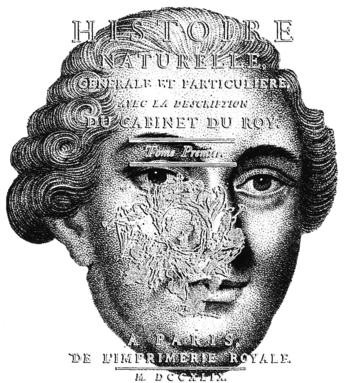George Leclerc, Comte de Buffon1707–1788
Natural histories, like that of and Roman encyclopaedist Pliny (c. 23-79), themselves have a long history and they are records of human curiosity. They provide catalogues of phenomena, classified according to some scheme, and they reflect the world view of their compilers. This certainly applies to Buffon, who is best known for his Histoire Naturelle, the first volume of which was published in 1749; he is shown in its titlepage. The remaining 35 volumes appeared over the next 29 years. It was translated into English several times over the following decades (and also in many other languages as well). Buffon was critical of the binomial classification (into genus and species) advocated by Linnaeus, although the plants in his Jardin du Roi in Paris were organised on these principles. The Linnaean hierarchical classification is still in use while Buffon’s more fluid system is forgotten. Prior to this massive compilation, Buffon had written about matters perceptual, and in it he had speculated on a range of visual and developmental phenomena. In his Histoire Naturelle Buffon considered problems of double vision and came close to describing retinal disparity, but he did not make that connection. Buffon was much taxed by combining images from each eye, as well as processing inverted retinal images. In these regards, he based his speculations on empiricist philosophy, considering that “Sight is a species of touching”. He also placed these deliberations in the context of visual development, and introduced some strange speculations that history has proved difficult to dislodge – namely that newborns initially see the world inverted and double! In 1743 Buffon published two memoirs concerned with vision – one on accidental colours and the other on strabismus. Afterimages had been described since antiquity and Buffon coined the term ‘accidental colours’ for those we would now refer to as complementary afterimages. They were contrasted to natural colours and he pointed to a relationship between them: “Thus there is a range of accidental colours which corresponds to the range of natural colours; red produces an accidental colour of green, yellow produces blue, green produces purple, blue produces red, black produces white, and white produces black”. At that time, coloured afterimages were called ‘spectra’ in English and ‘zufällige Farben’ in German. In this memoir, Buffon also gave a detailed description of the occurrence of coloured shadows (blue or green) in a natural environment. The second memoir was concerned with squint and binocular vision, or more specifically with diplopia due to eye dominance or deviation. Buffon was shortsighted and his left eye was stronger than his right, as was reflected in his analysis of squint.
